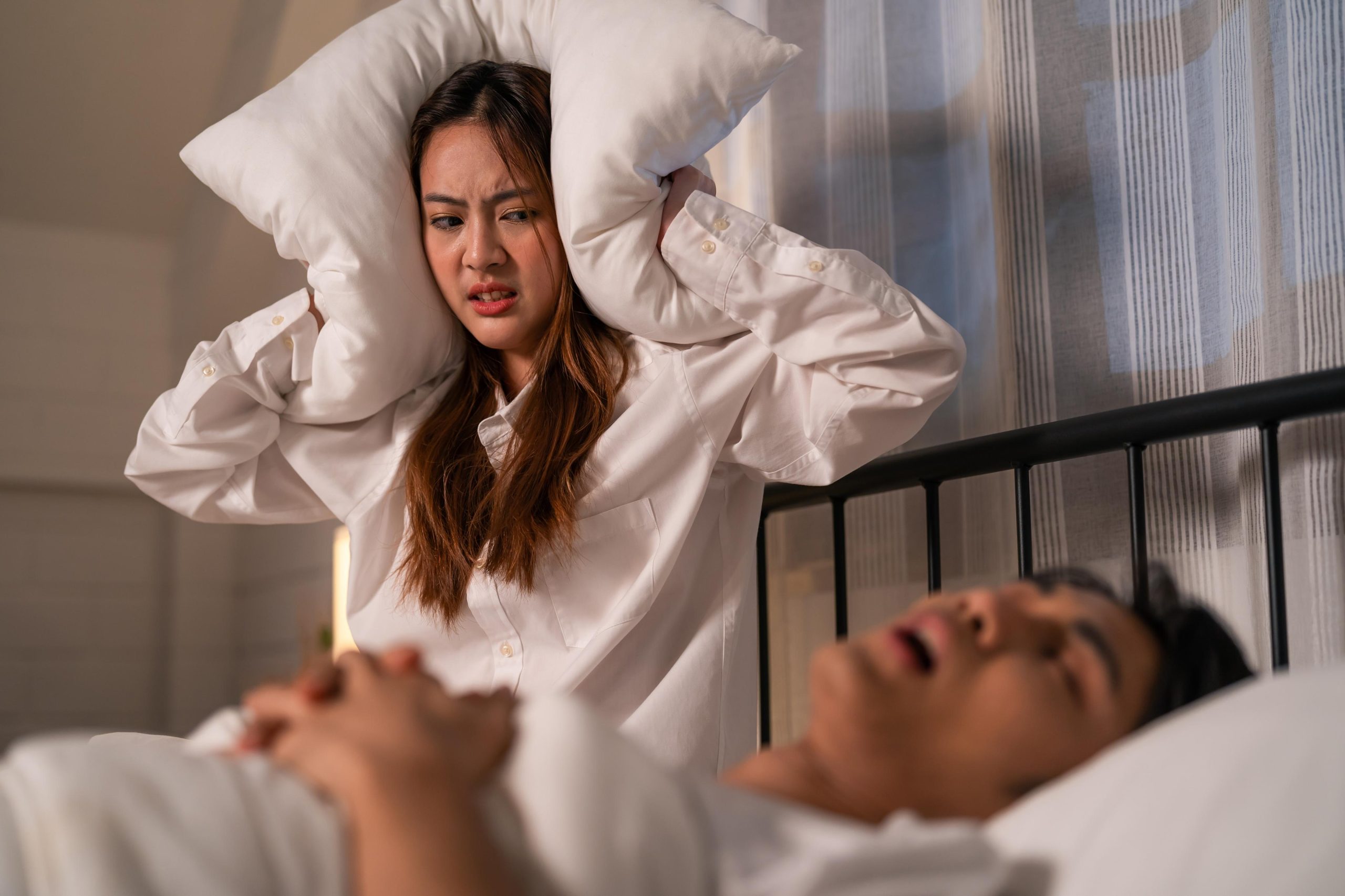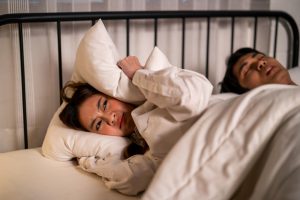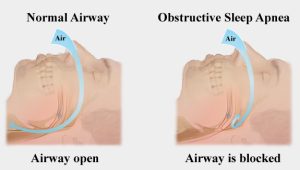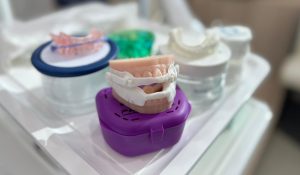Overview of Sleep Apnea
What is Sleep apnea?
Sleep apnea is a condition that causes you to stop breathing while you’re sleeping. This happens either because of blockage of your airway or because your brain doesn’t correctly control your breathing. When it happens, you may snore loudly or make choking noises as you struggle to breathe. As a result, your brain and body are deprived of oxygen, leading to frequent awakenings. This can happen a few times a night or, in severe cases, hundreds of times.
A sign of obstructive sleep apnea is snoring but it’s not just snoring. It’s a signal, a warning that the airway is blocked, halting breaths, jolting us awake. Obstructive sleep apnea not only disrupts restful sleep but can also have detrimental effects on overall health which may lead to potentially deadly consequences.
Who does sleep apnea affect?
Sleep apnea can affect individuals of all ages, genders, and backgrounds. While it can occur in anyone, certain factors may increase the likelihood of developing sleep apnea:
- Excess weight or obesity
- Certain anatomical factors, such as a large tongue or small chin that can cause narrowing or blockage of the airway, increasing the risk of breathing difficulties.
- Snoring gasping for air
- Family history
- Certain medical conditions such as high blood pressure and diabetes
- Age greater than 50
- Excessive daytime sleepiness
- Lifestyle factors, including smoking and alcohol consumption
How common is sleep apnea?
Obstructive Sleep Apnoea (OSA) is common and a worsening global health problem. According to recent findings from the Singapore Health Study, an estimated 30.5 percent of Singapore’s population has moderate to severe Obstructive Sleep Apnea (OSA).
Sleep apnea can occur at any age. However, it is more common in men than in women and tends to occur commonly between young adulthood and middle age.
Sleep apnea signs and symptoms
What are the symptoms of sleep apnea?
Sleep apnea has many symptoms, some of which are more noticeable than others. These symptoms may include:
- Loud Snoring– While snoring is a common feature of sleep apnea, it does not occur in all cases. It is possible to have the disorder without any snoring at all.
- Feeling tired or even exhausted when waking up – People with sleep apnea often feel extreme tiredness, even after getting a full night’s sleep.
- Daytime drowsiness – including falling asleep unintentionally when working, reading, watching TV, or drowsiness during driving.
- Pauses in breathing while asleep that others witness
- Morning headaches
- Waking up feeling short of breath or like you’re choking
- Memory or concentration problems
- Waking up frequently to urinate
- Difficulty staying asleep (insomnia)
- Dry mouth when you wake up
- Cardiovascular effects
There are 3 types of sleep apnea
- Obstructive Sleep Apnea (OSA) – this is the more common condition, where your throat and airway collapses during sleep, blocking air from reaching your lungs.
- Central Sleep Apnea (CSA) – this is a less common condition, central sleep apnea happens when your brain doesn’t send signals to keep breathing-related muscles working.
- Mixed Sleep Apnea – where there is a component of both obstructive sleep apnea and central sleep apnea.
Diagnosis and Tests
How is sleep apnea diagnosed?
Diagnosing sleep apnea involves obtaining your medical and family history, followed by a thorough physical examination to assess potential factors.
- Overnight sleep study (Polysomnography): This is an overnight test that takes place in a medical facility commonly known as a ‘sleep lab’. These facilities are designed to provide a comfortable environment while still monitoring your sleep. Polysomnography tests involve sensors that monitor your heart rate, breathing, brain waves, blood oxygen levels and more. This PSG test is painless and is recommended for complex cases or for patients with other medical conditions.
- Home-based portable monitor: Patients can complete the test from the comfort of their own homes with a home-based portable monitor, which is a simplified test conducted with a portable device.
Sleep Apnea Treatment
There are many approaches to treating sleep apnea, possible treatments include:
- Oral appliances (mouthpieces)
- Breathing devices (PAP)
- Surgery
- Conservative (non-medical) treatments
Oral Appliances (Mouthpieces)
Mouthpieces can be beneficial for individuals with mild sleep apnea or those who snore without having sleep apnea. These devices work by lifting the jaw and tongue, helping to open the airway during sleep. They are typically custom made and fitted by dentists and sleep medicine specialists.
Breathing devices
The Continuous Positive Airway Pressure (CPAP) machine is the most commonly used breathing device for treating sleep apnea. These devices work by increasing the air pressure within your airway and lungs when you inhale, preventing the surrounding tissue from pressing your airway shut.

Surgery
In cases where patients experience difficulty with the above treatments, surgical procedures may be necessary to address structural factors contributing to or causing sleep apnea. These procedures are typically performed by otolaryngologists (head and neck surgeons). Furthermore, the specific type of procedure depends on each patient’s unique anatomy and pattern of obstruction. Nasal surgery may be performed to treat congestion, deviated septums, or enlarged turbinates. While it is true that many sleep apnea patients have excessive soft tissue in the upper or lower throat and upper voicebox (epiglottis), which may require resection or stabilization. For example, large tonsils or adenoids can block the airway. Select patients may benefit from palate widening or advancement of the upper (maxilla) or lower jaw (mandible) to improve airway openness.
Conservative (non-medical) treatments
Mild sleep apnea can often improve through changes to daily habits and activities. This may involve:
- Weight loss – A decrease in body weight can improve sleep apnea for people who have excess weight or obesity.
- Treating the underlying condition – like heart failure can often lead to improvements in central sleep apnea symptoms.
- Sleeping on your side can help keep your airway open – Special pillows or shirts designed to prevent sleeping on your back can help in maintaining a side sleeping position.
The Dangers of Uncontrolled Sleep Apnea
Sleep apnea is a dangerous condition because it can cause several different complications, many of which are severe and potentially lead to deadly consequences.
- Heart damage and heart failure
- Sudden cardiac death
- Arrhythmias
- Daytime drowsiness resulting in motor vehicle accidents
- Affects workplace productivity
- Reduced libido
- GERD (Gastroesophageal Reflux Disease)
A Note from Royal Healthcare Medical Centre
Sleep apnea is a widespread condition that disrupts breathing during sleep, leading to frequent awakenings and a lack of restful sleep. Without proper diagnosis and treatment, it can have serious and potentially life-threatening complications. However, it is important to note that this condition is highly treatable, and there are various treatment options available.
Royal Healthcare Medical Centre offers multidisciplinary management of sleep disorders, which includes sleep physicians, respiratory specialists, neurologists, ear, nose, throat specialists, dental sleep medicine practitioners, and many more. Early diagnosis and intervention are critical in managing sleep apnea and preventing its potential complications. If you suspect that you or your loved one may be experiencing symptoms of sleep apnea, we highly recommend seeking medical attention and undergoing appropriate evaluations. We can guide you through the diagnosis process and work with you to develop an individualized treatment plan.
For any queries, you may contact:
 +65 8181 8671 / +65 6931 8000
+65 8181 8671 / +65 6931 8000





